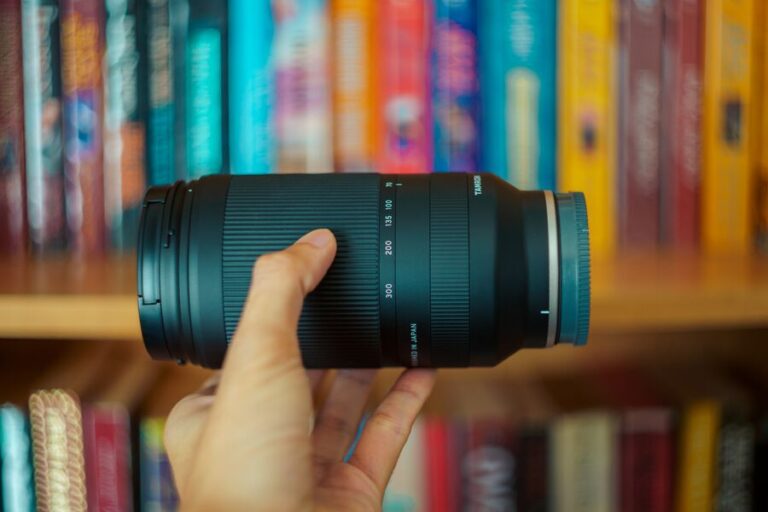For amateur and semi-professional photographers, telephoto zoom lenses are essential for wildlife, sports, and portrait photography. The Tamron SP 70-300mm f/4-5.6 Di VC USD offers a balance of performance, affordability, and portability. Here’s an in-depth look at what this lens brings to the table.
Key Features
1. Focal Length: 70-300mm
• The zoom range offers versatility, whether you’re capturing distant subjects or tighter shots at closer distances.
2. Vibration Compensation (VC):
• Tamron’s built-in image stabilization system ensures sharp images by reducing camera shake, especially when shooting handheld at longer focal lengths.
3. Ultrasonic Silent Drive (USD):
• Autofocus performance is quick and quiet, making it ideal for video and wildlife photography where silent operation is crucial.
4. Build Quality:
• Despite being lightweight, the lens feels sturdy. Its design caters to both Canon and Nikon DSLRs, with full-frame and APS-C compatibility.
5. Macro Capability:
• With a minimum focusing distance of 1.5m, it offers decent macro functionality for close-up photography.
Performance
• Image Quality:
• The lens delivers sharp images in the center of the frame, especially at shorter focal lengths. The sharpness softens slightly at 300mm, but this is expected for lenses in this category.
• Chromatic aberration and distortion are well-controlled, and the lens performs admirably under various lighting conditions.
• Bokeh:
• The lens produces smooth, creamy bokeh, making it suitable for portraits and nature photography.
Strengths
1. Value for Money: Compared to other 70-300mm lenses, this one is cost-effective without compromising key features.
2. Image Stabilization: The VC system significantly improves usability in low-light or slow shutter speed scenarios.
3. Silent Autofocus: The USD motor ensures seamless operation for both stills and videos.
Limitations
1. Low-Light Performance: With an aperture range of f/4-5.6, it may struggle in dim environments without additional light or a higher ISO.
2. Size and Weight: While portable for a telephoto lens, it may feel bulky for extended use without a tripod.
Who Is It For?
The Tamron SP 70-300mm f/4-5.6 Di VC USD is perfect for hobbyists and those looking to expand their photography beyond kit lenses. It’s an excellent choice for wildlife, sports, and outdoor photography.
For my Canon EOS 350D with the Tamron 70-300mm lens, here are some detailed settings for different types of shots which I frequently use:
1. Portraits (70-100mm):
• Aperture: f/4.5 – f/5.6 (This will provide a shallow depth of field to blur the background).
• Shutter Speed: 1/200s or faster to ensure sharpness.
• ISO: 400-800 (depending on lighting conditions). This helps with noise while keeping shutter speed fast.
• Focus Mode: One Shot AF (for still subjects).
• AF Points: Select a central focus point to get precise focus on the subject.
2. Wildlife (250-300mm):
• Aperture: f/5.6 to f/8 (provides a good balance between sharpness and depth of field).
• Shutter Speed: 1/1000s or faster (to freeze fast-moving animals).
• ISO: 800-1600 (you may need higher ISO for fast shutter speeds, especially in lower light).
• Focus Mode: AI Servo AF (for continuous tracking of moving subjects).
• Drive Mode: Continuous shooting (to capture multiple frames in quick succession).
• Metering Mode: Evaluative (helps with consistent exposure).
3. Sports Photography (100-300mm):
• Aperture: f/5.6 (this lets in enough light while keeping subjects sharp).
• Shutter Speed: 1/1000s or faster (depending on the speed of the sport).
• ISO: 800-1600 (raise ISO for faster shutter speeds).
• Focus Mode: AI Servo AF (to track moving subjects).
• Drive Mode: Continuous shooting for action shots.
• Metering Mode: Evaluative.
4. Landscape (70-100mm):
• Aperture: f/8 – f/11 (to maximize depth of field and ensure sharpness from foreground to background).
• Shutter Speed: 1/100s (longer if using a tripod for more detail).
• ISO: 100-200 (to minimize noise in the shot).
• Focus Mode: One Shot AF.
• AF Points: Use the center AF point for precision.
• White Balance: Daylight or Cloudy (depending on the scene’s lighting).
5. Close-Up Photography (70-100mm):
• Aperture: f/5.6 – f/8 (for a good balance of depth of field).
• Shutter Speed: 1/200s or faster.
• ISO: 200-400 (depending on lighting conditions).
• Focus Mode: One Shot AF.
• Metering Mode: Spot metering (to expose for the subject).
• Use a tripod for stability if you’re getting close to small subjects.
General Tips:
• Stabilization: The Tamron 70-300mm doesn’t have built-in image stabilization, so ensure you use fast enough shutter speeds (or a tripod) to avoid motion blur at longer focal lengths.
• Custom Functions: You can adjust settings like AF mode, and metering mode for specific shooting conditions using the camera’s custom functions.
• Shooting in RAW is recommended for maximum flexibility in post-processing.
With these settings, you should be able to capture sharp and detailed photos with your Canon EOS 350D and Tamron 70-300mm lens for various types of photography!
